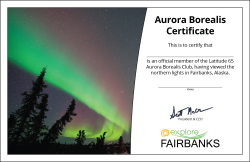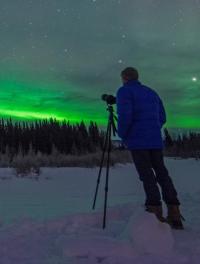




- Events
- Things to Do
- Places to Stay
- Restaurants and Shopping
- Planning Tools
- Explore the Area
-
Industry Professionals

Aurora Season
Fairbanks' renowned aurora viewing lures people from all over the world during Aurora Season. But why is Fairbanks, Alaska popular for viewing the northern lights and when should you visit? How do you look for the aurora and will you stay warm doing so? If you've thought of these questions, you’re not alone! Keep reading to have these frequently asked questions answered and get other useful information about this magnificent natural phenomena.
Northern Lights in Fairbanks
It's no surprise that with Fairbanks' location, it is frequently referred to as the best place to see the northern lights in Alaska, the United States and in many cases, across the globe.
There are many different ways you can hunt for the aurora. You can drive to a nearby vantage point and wait for them to appear, or take a tour and watch them from a heated “aurorium” cabin, yurt, dome or lodge. You can also see them on a dog sled adventure or while you are ice fishing, on a snow cat tour, via a trip part way up the Dalton Highway or even on a flight above the Arctic Circle.
Ask your accommodation’s front desk if  they offer a wake-up call when the northern lights are out. No guarantees, but the longer you’re here, the better your chances of seeing a great light show. Once you've spotted the aurora borealis, stop by the Morris Thompson Cultural and Visitors Center for your personalized Aurora Certificate.
they offer a wake-up call when the northern lights are out. No guarantees, but the longer you’re here, the better your chances of seeing a great light show. Once you've spotted the aurora borealis, stop by the Morris Thompson Cultural and Visitors Center for your personalized Aurora Certificate.
Aurora Viewing Map & Guide
Use the brand-new Aurora Viewing Map & Guide to plan your aurora viewing adventure in the Fairbanks area. In addition to an easy-to-use map detailing northern light vantage points, you'll find science information, pro tips for aurora chasing and FAQs.
While you're in Fairbanks, a printed copy can be picked up at the Morris Thompson Cultural and Visitors Center, local hotels or through tour operators.
 I saw the northern lights for the first time in Fairbanks and literally teared up—huge green and violet curtains pulsating and swirling across the sky. I couldn't believe how vibrant and fast they were.
I saw the northern lights for the first time in Fairbanks and literally teared up—huge green and violet curtains pulsating and swirling across the sky. I couldn't believe how vibrant and fast they were.
View the wonder of the northern lights in Fairbanks with this short video!
Aurora Viewing FAQs
Why is Fairbanks such a great place to view the northern lights?
Fairbanks’ location is ideal for northern lights viewing because it is under the “Auroral Oval,” a ring-shaped zone over the far north where aurora activity is concentrated. Additionally, Fairbanks’ low precipitation and distance from coastal areas contribute to consistently clear nights. All combined these variables make the Fairbanks region an outstanding destination for possible aurora borealis viewing.
When is the best time to see the northern lights?
Fairbanks’ Aurora Season is from August 21 to April 21 and the aurora will be visible in Fairbanks an average of four out of five nights when the sky is clear and dark enough. Scientifically speaking, the aurora is dancing above year-round, but we can only see it during the Aurora Season when we have dark enough skies.
Am I going to see the aurora if I visit Fairbanks?
The northern lights are so prolific in the Fairbanks region and the Arctic that visitors who stay a minimum of three nights and are actively out during the late evening hours increase their chance of seeing the aurora to more than 90 percent!
How can I see the aurora?
There are so many different ways, but a great way is to take a northern lights tour with a guide. You can view them from a heated “aurorium” cabin or lodge, see them on a dog sled adventure, on a snow cat tour, via a trip part way up the Dalton Highway or even on a flight above the Arctic Circle. Or perhaps you want to go fishing while you wait and go on an evening ice-fishing adventure on a local lake! All of these are great options, or if you are a do-it-yourself adventurer, you can drive to a nearby vantage point and wait for them to appear. See below for accessible spots around Fairbanks.
What colors will I typically see on my visit?
Visitors will most typically witness a swirling array of green, teal, and white. An intense aurora can get a purple or magenta edge. The aurora takes on different shapes such as curtains, bands, rays and coronas.
What should I wear to go aurora hunting?
Layers, layers, layers and dress warmly! You will likely be out in the elements for extended periods of time. Rely on synthetic, wool, and fleece materials, especially in the winter. For more on how to dress for winter pursuits, watch this video.
In The Media
-

The Best Places (and Time) to See the Northern Lights
In Fairbanks itself, residents see the northern lights on about eight of every 10 nights. More
-

Northern Lights: 11 places to see the aurora borealis
The city of Fairbanks, in Alaska, is often cited as the best place to see the Northern Lights in the United States. More
-

7 Magical Places to View Auroras
Fairbanks is the best place in the U.S. to take in the northern lights. More
-

Best Places to See the Northern Lights
Fairbanks lies directly beneath a band of aurora activity, meaning from August to May, the town regularly experiences a celestial display of green, yellow, and purple. More
How to Photograph the Aurora
- Read this blog post with helpful tips and tricks from local guides.
- Locate a dark area with minimal light pollution. Point your camera at the northern sky and compose your medium-distance foreground with a fixed object such as trees, hills or a cabin.
- Use a digital camera with manual settings and a solid tripod.
- Use a remote shutter to minimize camera shake.
- Bring extra camera batteries and a flashlight or headlamp and dress for extended times outdoors.
- Manually set your camera on its highest ISO setting, widest focal point and lowest aperture.
- Expose each shot for approximately 5 to 10 seconds. Longer exposures will result in brighter images, but stars will streak and the aurora will soften. Short exposures may have sharper detail but dimmer images.
- Every aurora and camera is distinctive, so experiment with different settings and exposure times to get the best shot.
101 Dunkel Street, Suite 111
Fairbanks, AK 99701-4806
Telephone: (907) 456-5774
Visitor Guide Request: 1-800-327-5774
Email: info@explorefairbanks.com
About Explore Fairbanks
Visitor & Winter Guides


